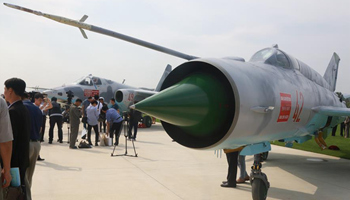SAN FRANCISCO, Sept. 25 (Xinhua) -- Researchers have combined sensor and video technologies to reveal how whales, the largest animals to ever have existed on Earth, subsist on krill and fish, sometimes as small as a paper clip.
Unique to rorquals, a family of baleen whales that includes blue whales, humpbacks and minke whales, is known as lunge feeding, that they, as in a 160-ton blue whale' s case, swims around 4 meters per second, opens triple-hinged jaws and take in a gulp equal to about 140 percent of its mass, slows back down to filter its snack and prepare for the next one.
"This feeding process is facilitated by a complex suite of biomechanical and anatomical adaptations that together allow the whales to engulf a volume of water and prey that is larger than their own body," said Jeremy Goldbogen, assistant professor of biology at Stanford University and co-author of a report in Current Biology. "For a large blue whale, this represents a volume of water and prey that is approximately the size of a large swimming pool or a school bus, and this is engulfed in a matter of seconds."
To gulp down a mouthful of krill or fish, rorquals have to time their lunge just right. The enormous intake slows them down rapidly due to the drag caused by opening their mouths and the added burden of the water they take in. And performing this behavior at deep depths can make it even more energetically costly, as they dive down to 300 meters and hold their breath for 12 minutes or more.
In an effort to have a precise understanding of this process and acquire some clues as to how these massive animals survive on tiny prey, researchers from Stanford's Hopkins Marine Station worked with other whale researchers and engineers to develop a sensor package that housed miniaturized versions of typical movement technology plus new video recording capabilities, attached these tags to whales in South Africa, Patagonia, and off the west and east coasts of the United States, so that the resulting video is what viewers would see if they were riding on the whale' s back.
"Combining these two modalities is really eye-opening," David Cade, lead author and PhD student in biology at Stanford, was quoted as saying by a new release from the university in northern California. "Every time we do a deployment, we get something back that' s new and interesting."
The researchers found that whales that fed on krill followed a distinct pattern of activity: they opened their mouth at peak speed and closed it around the time they were back to normal speed. Humpbacks that fed on fish, however, varied their timing. This is likely in response to the more advanced escape abilities of fish compared to krill; the whales may be performing lunge feeding that is less energetically ideal when the trade-off is eating prey that can supply them with more energy.
With more detail than ever before about whales' mealtime activities, the researchers hope they can help biologists develop more effective conservation efforts, as most populations of humpback whales will be removed from the endangered species list effective from October 11. However, accounting for that change, three of the eight species of rorquals are still endangered.










